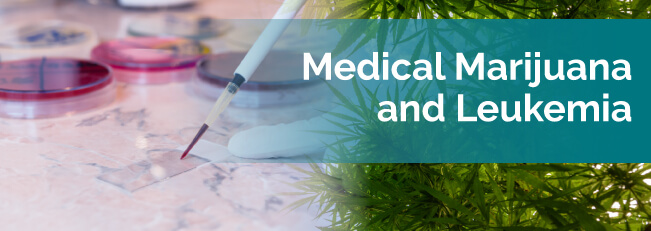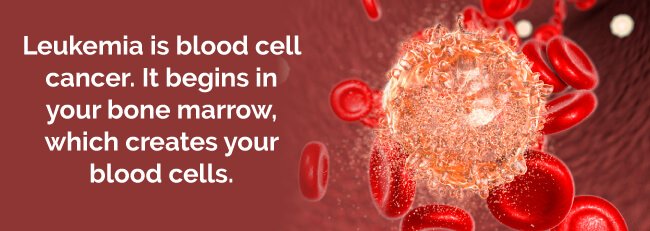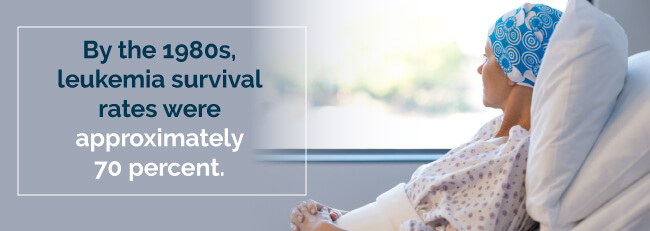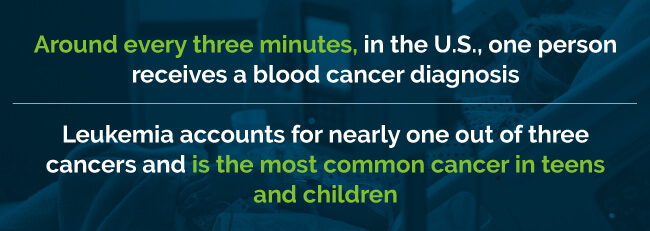
Did you know that cannabis can alleviate some symptoms of cancer and the painful side effects of certain cancer treatments? Since cannabinoid treatments are growing in availability, cancer patients are increasingly beginning to look to medical marijuana to help fight their cancer.
Medical marijuana is becoming more popular as a treatment for leukemia due to its cancer cell fighting properties and therapeutic effects. You may find that knowing more about the benefits of medical marijuana and leukemia may help you better cope with the condition and its treatment.
New research has revealed that cannabinoids increase the effectiveness of chemotherapy treatments in leukemia patients. UK researchers found that THC and CBD, the two major cannabinoids, were both effective when combined with chemo. However, the effect dramatically improved when used simultaneously. Pot’s overall medical effects also increase when you pair marijuana with coconut oil or other substances.
To relieve nausea associated with chemo and cancer-related pain, many patients often turn to cannabis and leukemia treatment. But weed has recently been growing in popularity as a treatment for leukemia and other types of cancer.
Evidence shows that medical cannabis is a viable treatment option for leukemia. Researchers found that the THC cannabinoids in medical marijuana can kill leukemia cells. Research also shows that, unlike chemo that targets cancer cells and healthy cells alike, medical pot only targets the cancer cells, not the healthy cells.

Researchers credit the widespread medical applications of marijuana to the endocannabinoid system (the natural cannabinoid system of your body.) What they found is that cannabinoid receptors are in many parts of your body, even your white blood cells. Because of this, researchers are continuing their promising investigation of marijuana for leukemia.
Find A Doctor Find A Dispensary
A study from 2005 looked into the role of mitogen-activated protein kinases (MAPKs) in cannabinoid-induced leukemia cell death. Some types of MAPKs take part in apoptosis and autophagy, or cell death and turnover. Understanding how cannabis causes cancer cell death can help us learn how to make better treatments, so the researchers behind this study specifically examined the CB2 receptor.
Before observing the cell death process, the team reaffirmed that their leukemia cells had CB2 receptors. After confirming their presence, they administered THC and another CB2-related cannabinoid. A type of MAPK called p38 MAPK activated in response to CB2 receptor stimulation, showing a link. Blocking p38 MAPK lessened the CB2 receptor’s ability to kill leukemia cells.
Another study supported the possibility of using cannabis as a supplement to radiation therapy. When a team from Israel observed the effects of CBD and a synthetic counterpart on leukemia cells, they recorded the effects that occurred in cells with and without prior gamma radiation exposure.
While the compounds killed plenty of leukemia cells on their own, they worked even better when used after radiation therapy. Without radiation, CBD killed about 61% of cells, while the synthetic counterpart killed around 43% of leukemia cells. But, those numbers respectively rose to 93% and 95% for cells with previous radiation exposure.
Medical marijuana helps ease the following cancer symptoms in patients:
Oral cannabis provides anti-cancer effects and causes a decrease in leukemic blast cell count.
Pain is a common and dreaded chemotherapy side effect. While marijuana might not be something you’re interested in, it can help relieve chronic pain. Many patients prefer it over opioid painkillers.
Painkilling strains of marijuana include:
Depression fighting strains include:
Fatigue and Insomnia fighting strains include:
Nausea and Vomiting strains include:
Stress fighting strains include:
Lack of Appetite strains include:
With medical cannabis growing in popularity, there are many new methods of consuming marijuana. These newer methods allow you to benefit from the plant’s therapeutic potential for leukemia and other medical conditions.
When you think about medical weed, your first thought is probably an image of someone lighting up a joint. Although this is a popular way to consume this miracle drug, it’s not the healthiest. By inhaling cannabis, most of the cannabinoids are entering your body through your lungs and passed to your bloodstream. Because of this direct exchange, you’re shortening its effect.
Some better methods of consuming your medical weed include:
Even though medical marijuana is presently federally illegal in the U.S., it’s legal in many states for valid medical use. To qualify for medical cannabis, you must first receive a diagnosis of a qualifying condition and obtain a local doctor’s recommendation for a medical marijuana card.
To find out if your state has legalized the use of medical cannabis, you can check our list. Then just search for a medical marijuana doctor to receive your cannabis for leukemia.
Find A Doctor Find A Dispensary

Leukemia is blood cell cancer. It begins in your bone marrow, which creates your blood cells. With leukemia, immature blood cells turn into cancer. Blood cells have different functions:
With leukemia, abnormal white blood cells known as leukemia cells form from your bone marrow. These abnormal cells don’t do the work that your normal white blood cells do. They grow faster than normal cells, and they continue to grow when they shouldn’t.
As time passes, leukemia cells begin crowding out your healthy blood cells. Serious problems can arise from this such as bleeding, infections and anemia. Leukemia cells may also begin spreading to your lymph nodes or other organs, resulting in pain or swelling.
Leukemia may come on quickly or gradually. Slow growing leukemia is chronic. With acute leukemia, abnormal cells increase in number quickly.
Patients who have slow-growing leukemia may not have symptoms. Patients who have quick-growing types of leukemias may experience symptoms, including:
These symptoms may start off mildly but can become more pronounced as leukemia advances.
Children often develop acute leukemia while adults may have either acute or chronic. Doctors can cure some types of leukemia. Other types of leukemia can’t be cured and can only be controlled.
Treatments might include radiation, chemotherapy or stem cell transplantation. These are the most common treatments although there are several others described below. You may require therapy even if your symptoms go away, to prevent a relapse.

There are several types of leukemia, categorized by the type of white blood cells affected and the rate in which it worsens.
The four primary types of leukemia are:
AML causes your body to generate too many white blood cells, known in this case as myelocytes. Leukemia cells begin building up in your bone marrow and blood, leaving less room for your healthier blood cells. The symptoms of AML include easy bleeding, infections and anemia. AML affects men more than women. It also affects kids. As you age, the incidence of AML can increase.
ALL also causes your body to generate too many white blood cells known as lymphocytes. These leukemia cells can’t fight infection effectively. The cells build up in your bone marrow and blood and don’t leave much room for your healthy blood cells. Easy bleeding, infections and anemia can result. ALL typically develops and worsens in a very short span of time.
CML causes the same reaction as AML and ALL. It worsens slowly and is more common in men than it is in women. CML is most common in adults in their 50s, and rarely affects children.
The same reaction happens with CLL as the other leukemia types. It’s most common in adults who are in their 60s, and more common in men than women. Children don’t often develop CLL. Patients with CLL tend to get more infections since it compromises the immune system.
There are other types of leukemia that aren’t as common, such as hairy cell leukemia. Leukemia also has subtypes, like the subtype of AML known as acute promyelocytic leukemia.
In 1845, John Hughes Benett officially identified leukemia as a diagnosis in Edinburgh. In the 19th century, other European physicians recognized abnormally high white blood cell levels in their patients, calling it “weisses blut” that meant “white blood.” Today, “leukemia” comes from the Greek terms “leukos” and “heima” that also means “white blood.”
The formation of four types of leukemia occurred in 1913. They were:
In 1970, doctors confirmed that some patients could be cured of leukemia. By the 1980s, leukemia survival rates were approximately 70 percent.

The symptoms you experience with leukemia depend on what type of the disease you have. Common signs and symptoms of leukemia may include:
Besides the physical effects of leukemia, this disease can also affect your mental well-being. A cancer diagnosis can change your life. It may overwhelm you, and the side effects of treatment can make it difficult to handle everyday life stresses.
Your mood can change at any time once you receive your diagnosis. Some people struggle with anxiety or depression immediately following their diagnosis. Other people’s mood may change during treatment. Your body may have both mental and physical reactions to cancer treatment.
Although it’s harder to recognize mental changes, they can be just as hard to deal with as physical changes. However, it’s important to recognize and manage changes in mood. Some mood change symptoms may include:
Facts and Statistics reported by the Leukemia & Lymphoma Society include:

The American Cancer Society says:
To recommend a treatment protocol for leukemia, doctors perform several tests to diagnose the condition. These include conducting a complete blood count and performing a tissue biopsy from your bone marrow and possibly other organs such as your spleen and liver.
Treatments for cancer, such as chemotherapy medications, may impact how you feel physically and emotionally. They may disrupt your sleep and cause nausea, depression, loss of appetite, fatigue and anxiety.
Your leukemia treatment plan depends on several factors. Your physician recommends the treatment best for your leukemia case based on your overall health, age, the type you have and if the cancer is spreading to other body parts.
Common treatments doctors typically prescribe for leukemia include:
Chemo is a major type of leukemia treatment. It consists of chemicals that kill leukemia cells. Your doctor may give you one dose or a mixture of drugs depending on your type of leukemia. It may come as an injection or a pill.
Side effects of chemotherapy include:
Biological therapy helps your immune system identify leukemia cells and attack them.
Side effects of biological therapy include:
Targeted therapy attacks specific cancer cell vulnerabilities. For instance, Gleevec (imatinib) stops protein action in leukemia cells when you have chronic myelogenous leukemia helping to control leukemia.
Side effects of targeted therapy include:
Radiation therapy consists of high-energy beams like X-rays that damage leukemia cells, stopping them from growing. Your doctor may apply radiation over your entire body or just a certain area of your body if there’s a concentrated group of leukemia cells. The doctor may give you radiation therapy before a stem cell transplant to prepare you for the procedure.
Side effects of radiation therapy include:
A stem cell transplant replaces unhealthy bone marrow with bone marrow that’s healthy. You’ll receive a high dose of radiation therapy or chemotherapy before your stem cell transplant procedure to destroy your unhealthy bone marrow. Your doctor will then give you an infusion that contains stem cells that form blood to help rebuild your bone marrow. Your doctor may use your stem cells or stem cells from a donor.
Side effects of stem cell transplant include:


Please allow us to access your location to find local dispensaries.
VIEW ALL DISPENSARIES ➔